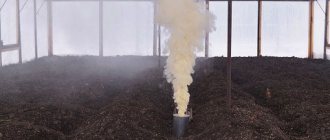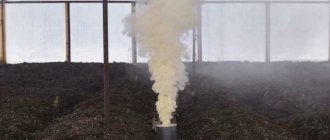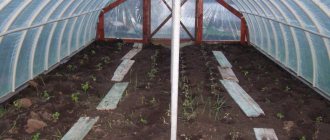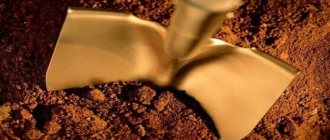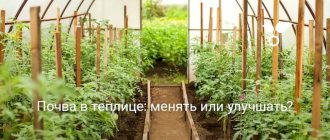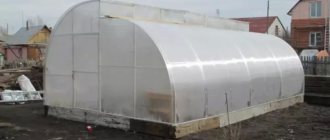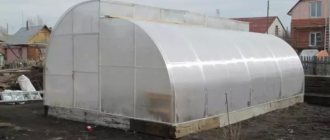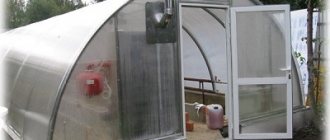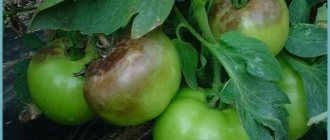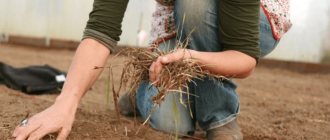Plants in closed ground are susceptible to many diseases and pest attacks. Annual disinfection of the greenhouse using a sulfur bomb will help to avoid this. This method of disinfection allows you to get rid of diseases and insects in one or two procedures.
The technology for fumigating greenhouses with smoke bombs is quite simple, but for it to be effective and safe, the instructions must be strictly followed.
Sulfur block for polycarbonate greenhouse
The benefits and harms of sulfur bombs for polycarbonate greenhouses
Treating greenhouses with smoke often gives a more noticeable effect than using various drugs or folk remedies. Sulfur gas, circulated during combustion, penetrates well into the soil and hard-to-reach corners, destroying a wide variety of pests. The use of sulfur bombs provides several advantages:
- The product is versatile. It allows you to completely destroy almost all common insect pests, as well as fungi, bacteria and viruses.
- The processing is quite simple, even a novice amateur can handle it.
- Minimal labor costs: no need to dilute the solution, walk next to the bushes and spray them. It is enough to set fire to a few pieces and immediately leave the greenhouse.
- Affordability – checkers, as a rule, are cheaper than even the most common drugs. In addition, they replace both insecticides and fungicides.
However, this tool also has several disadvantages:
- Care must be taken to observe safety precautions and observe the emission of smoke for fire safety purposes. Sulfur dioxide in high concentrations can be harmful to health.
- The gas released during combustion has a bad effect on metal structures. Therefore, they must first be treated with a primer or grease.
It is important to understand that fumigating a greenhouse with a sulfur bomb is allowed in the fall and spring, when there are no plants in it. Burning during other periods (summer) is dangerous for seedlings. If at this point there are problems with insects and other pests, insecticides, fungicides and folk remedies should be used.
Sulfur powder is ignited from the wick
Pros and cons of the product
The benefits and advantages of using sulfur-based smoke fumes are obvious:
- disinfection of greenhouses, and, if necessary, basements and cellars;
- versatility - the product immediately fights mold, microorganisms and insects, there is no need to use different groups of drugs (insecticides, fungicides);
- the scale of the impact - toxic smoke penetrates into all corners of the greenhouse, where it is difficult to reach with a sprayer;
- ease of use - checkers are sold ready-made, you just need to calculate the exact quantity for your greenhouse;
- availability of purchase;
- efficiency.
Also consider the negative aspects associated with fumigating a greenhouse with sulfur:
- if you do not follow safety rules, you can be seriously exposed to a caustic substance that is released during combustion;
- sulfur dioxide has a negative effect on the metal elements of the greenhouse. To protect the frame from destruction, it should first be coated with a primer, painted or treated with grease;
- the substance does not affect pathogens that are located in the deep layers of the soil;
- in this case, the top fertile layer of soil may be damaged by combustion products.
Keep in mind. It is believed that repeated sulfur treatment harms polycarbonate. It becomes cloudy and covered with cracks.
Operating principle
The composition of the sulfur bomb contains dry substances, and the active substance is sulfur (in dry powder form) in an amount of 750-800 g per 1 kg of mixture. When burned, it combines with oxygen and forms sulfur dioxide SO2, which completely destroys various plant pests:
- insects;
- viruses;
- bacteria;
- fungi.
This substance also repels rats, mice and other rodents.
The combustion process is slow, without the formation of an open flame. After the protective surface (packaging lid) burns, the powder begins to smolder, releasing abundant, thick smoke of a dark yellow, brownish color. Thanks to the closed space, massive death of insects and other pests is observed already on the day of treatment.
The principle of operation of the checker is based on the destruction of pests by smoke generated by the combustion of sulfur. Important! The sulfur gas released during combustion actively absorbs moisture from the air, which makes it possible to cope with mold and rot.
Today you can purchase several types of sulfur bombs. They differ in the amount of active ingredient and packaging (different weights). Therefore, during the application process, you need to correctly calculate the amount based on the fact that 300 g is enough for every 5 m3 of the greenhouse.
The most famous are:
- FAS;
- Climate.
The FAS sulfur block for a polycarbonate greenhouse has a high sulfur concentration - 800 g of dry matter per 1 kg of mixture. Copes well with pathogenic bacteria, fungi, rot, mold and insect pests. It dehumidifies the air, making it suitable not only for treating greenhouses, but also for storing vegetables (basements, cellars, storage rooms).
The product is sold in briquettes of 300 g. They should be stored in a dry place at room temperature. Shelf life is 5 years if storage conditions are met.
FAS sulfur bomb is used for combustion in greenhouse structures, basements and cellars
In accordance with the instructions, the sulfur smoke bomb Climate for a greenhouse is used to treat any utility premises. The sulfur concentration is 750 g per 1 kg of mixture. The product is sold in briquettes of 300 g, 40 pieces are packed in one box.
Consumption depends on the type of room:
- For empty greenhouses, greenhouses and greenhouses, 300 g per 20 m3 is sufficient.
- For empty basements, cellars, storages – 300 g per 10 m3.
Important! After treatment, it is recommended to ventilate greenhouses for 8-10 days in a row, and basements for at least two days.
Checkers are packaged in 300 g pieces - this amount is enough for 10-20 m3 of space
Calculation and preparatory work
Each manufacturer provides their product with detailed instructions. From it you can find out how many tablets are needed to treat the greenhouse. Most often per 1 cubic meter. It is recommended to use 60 g of sulfur. Therefore, if you buy a briquette weighing 300 g, this will be enough for 5 cubic meters. m.
Note! We are talking specifically about the volume, not the area of the greenhouse. To find out this value, you should multiply the length, height and width of your greenhouse.
Calculation example. Initial design data: 2x3x6 m. It turns out 36 cubic meters. m. For such a greenhouse you need to buy 7 sulfur blocks of 300 g each or 3-4 pcs. 600 g each
Having calculated the required amount of active ingredient, proceed to prepare the room:
- remove weeds and debris;
- dig up the soil to raise overwintering pest larvae to the surface of the beds;
- remove all equipment;
- wash the internal elements of the structure with soap and rinse;
- close the windows tightly and seal any cracks;
- properly process the metal parts of the greenhouse;
- Prepare stands made of non-combustible material (for example, bricks) for checkers.
Instructions on how to use a sulfur bomb in a greenhouse
The rules for using checkers are quite simple. It does not give off an open flame, so it does not pose a particular fire hazard. A sulfur bomb is used against spider mites and other pests in a greenhouse according to the following instructions:
- Preparatory stage - it is necessary to remove all metal objects, preparations (cans), collected fruits and vegetables from the premises. If any metal products remain, they need to be coated with grease or other lubricant.
- Seal the holes, seal small cracks on the outside with tape.
- Thoroughly loosen the ground so that the smoke penetrates as deeply as possible into the soil and destroys insects in various forms (eggs, larvae).
- Calculate the required number of sulfur bombs and arrange them evenly over the entire area of the greenhouse. The surface must be fireproof, because during combustion the checker becomes very hot. It is optimal to place them on bricks.
- Put on a respirator mask, safety glasses, carefully gather all your hair into a bun and throw it over your back.
- Quickly light the wicks and immediately leave the greenhouse, tightly closing the door from the outside. It is better to ignite it in the open air so that the flame flares up better. The saber must be carried at arm's length, without touching clothing or the body.
- Using a sulfur bomb in a polycarbonate greenhouse is a rather lengthy process. Combustion lasts 1-1.5 hours, but after this the greenhouse is kept closed for at least a day. During this time, you can only enter the greenhouse if absolutely necessary, and it is advisable to wear a mask and goggles (for swimming).
- Then thoroughly ventilate for another two days and close the door. Seedlings can be planted after 1 week.
Important! If you burn a checker in a cellar or basement, you can put vegetables there no earlier than 5 days after the end of ventilation.
During processing, it is best to place the sulfur bomb on bricks
How many sulfur bombs are needed for a greenhouse?
The rate of treatment of a greenhouse with a sulfur bomb depends on the specific preparation. Basically, the concentration of the active substance (sulfur) is approximately the same - 750-800 g per 1 kg of mixture. Therefore, the following consumption rules have been established:
- when processing greenhouses, hotbeds and greenhouses 60 g/m3;
- when processing cellars and basements for storage 30-60 g/m3.
Accordingly, to process every 5 m3 of a greenhouse, you will need 1 sulfur block of a standard weight of 300 g. For example, if you take a standard greenhouse 3 m wide, 6 m long and 2 m high, the volume will be 3 * 12 * 2 = 72 m3. To process such a volume, you need to take 72/5 = 14 sulfur bombs.
Instructions for use
Before setting fire, you need to water all the surfaces of the greenhouse so that the “smoke” will smolder longer. It is most convenient to use a hose. After that:
- Place the tablets evenly on stands around the perimeter of the greenhouse. You can place the entire workpiece in the center of the room.
- Light the fuse. In conditions of high humidity it may burn poorly. Some summer residents advise using a little kerosene for ignition, but in no case gasoline.
- As soon as you see that a fire has appeared, immediately leave the greenhouse and close the door tightly. The wick burns for approximately 1.5-2 minutes.
The checker will smolder for several hours. But you can’t open the greenhouse right away! For better disinfection, leave it sealed for another 2-3 days. After this, ventilate the greenhouse for several days.
There is no need to wash the greenhouse after burning the sulfur bomb. Better take care of soil fertility, which can be degraded by toxins. After fumigation, fertilize the soil and treat it with preparations containing beneficial bacteria.
When to treat a greenhouse with a sulfur bomb
It is best to apply the treatment in early autumn. Also in some situations, a spring procedure is allowed. But this product cannot be used in the summer - there should be no plants in the greenhouse.
When to treat a greenhouse with a sulfur bomb in the spring
In the spring, burning checkers is necessary only in 2 cases:
- For some reason, the procedure was not carried out last fall.
- The pest invasion was very large; many bushes suffered from fungi and other pathogens.
It should be noted that in the spring, the treatment of the greenhouse with a sulfur bomb is carried out only in April or even in May, when the soil has warmed up to at least 10 degrees Celsius.
Sulfur bomb in a greenhouse in autumn
Autumn is the optimal time for burning sulfur bombs in a greenhouse. You can start the procedure immediately after harvesting. The area is cleared, all flammable materials, liquids and objects are removed, and then several bombs are set on fire according to the instructions. Repeated treatment is carried out only in cases where there was a severe insect infestation in the summer. This can be done after 1-2 days.
Particular attention should be paid to the air temperature. It is better to treat the greenhouse with a sulfur bomb in early autumn, when the daytime temperature is consistently above 10-15 degrees. The fact is that if it is cool outside or even freezing, sulfuric acid will begin to form as a by-product. It is well absorbed by the soil and can impair fertility.
The optimal period for processing the greenhouse is the second half of September
Types of smoke bombs
Which sulfur bomb should I choose for processing a polycarbonate greenhouse? This question worries many novice summer residents. Often, sulfur bombs are mistakenly classified as means for killing insects and microorganisms based on other toxic substances. The scope of application of the smoke bomb and its effectiveness depend on the active substance.
Table 1. Types of smoke bombs.
| Type of smoke bomb | Description |
| Checkers FAS, Climate, Pawn | Sulfur-based checkers are used to get rid of fungal and bacterial infections, mold, and rot. They are also effective against insect pests: spider mites, aphids, thrips, whiteflies, leaf-eating caterpillars, slugs. It inhibits plants; treatment is carried out only in an empty greenhouse after complete harvesting of the crop and plants. |
| Checkers G-17, G-20 | Smoke bombs based on hexachlorane, a systemic insecticide with contact-intestinal action. Effective against aphids, caterpillars, thrips and whiteflies. They have no noticeable effect on herbivorous mites. They are also useless against diseases. Use during the growing season is not allowed. |
| Checker Whist | Checkers with didecyl-dimethyl-ammonium bromide have a pronounced fungicidal and bactericidal effect, and also kill insect pests. Checkers with bromide effectively fight wet rot and fungal infections. It is allowed to use the checker in the first weeks of the plant growing season, even before the start of fruiting. |
| Checkers City, Quiet Evening, Tsifum | Checkers based on permethrin have a wide range of effects on insect pests. Effective against all types of aphids, caterpillars, mites, thrips, whiteflies, as well as their larvae. Checkers with permethrin are fireproof, their surface does not heat up when fumigated. They do not inhibit plants and can be used during the growing season before fruiting begins. |
| Checkers Vulcan, Hephaestus | Tobacco sticks, the active ingredient is nicotine. Used in greenhouses during any growing season and after harvesting to combat harmful insects: aphids, whiteflies, spider mites, thrips, most butterflies and caterpillars. Smoke has practically no effect on the larvae, so twice treatment is required with an interval of 10-15 days. Tobacco sticks are useless against rot and infections. |
A type of insect checker
As can be seen from the table, sulfur bombs have the widest spectrum of action, so they are most often chosen for complete disinfection of greenhouses after the end of the season. In order not to harm the soil, greenhouse frame and polycarbonate, it is necessary to follow the processing technology.
Is it necessary to wash the greenhouse after a sulfur bomb?
After burning a sulfur bomb, it is not necessary to wash the greenhouse; on the contrary, to maintain a long-term effect, it is better not to do this. However, 2 days after ventilation it is worth inspecting the room. If there is mold on the walls, after exposure to smoke it will become soft, so cleaning it off will not be difficult.
Also, after the procedure, it is advisable to add bacterial fertilizer to the soil, for example, Nitragin, Phosphorobacterin, Azotobacterin and others. If they are not there, you can also add organic matter - urea, chicken droppings, manure.
Treating a greenhouse with copper sulfate
The task is to wash the entire greenhouse from the inside with a solution of copper sulfate or Bordeaux mixture, which also contains microorganisms. This can be done manually, using a soft rag or sponge, or using a sprayer. With this procedure, part of the solution will inevitably fall on the ground. And here again there are two ways: either remove the layer of soil on which the copper sulfate has fallen, or leave everything as it is. Naturally, this is not fatal for people, but some part of this chemistry, of course, will reach our table through the fruits.
Safety regulations
When handling a smoke bomb, you must strictly observe safety precautions - the smoke is poisonous to animals and humans. First of all, you need to take care of protecting your respiratory organs and eyes, wear a respirator and goggles. If you inhale smoke, immediately get out into fresh air.
Expert opinion
Zarechny Maxim Valerievich
Agronomist with 12 years of experience. Our best country expert.
Ask a Question
Store sulfur bombs in the original packaging, hermetically sealed. No moisture should penetrate them to prevent them from becoming damp. Storage temperature is room temperature. The shelf life of the disinfectant is 5 years.
Mechanism of operation
Sulfur blocks are produced in the form of tablets (5-10 pieces in a package), which contain 750 g of active ingredient per kg of product. Once ignited, they begin to smolder and emit smoke, which contains sulfurous anhydrite and sulfurous acid. Poisons kill microorganisms and pests and repel rodents.
Smoke envelops the walls of the room and internal structures, disinfecting them. After treatment, pests, bacteria, and viruses die even in the most inaccessible places. That is, a complete disinfection of the room is achieved, which is unattainable with the help of other chemicals.

